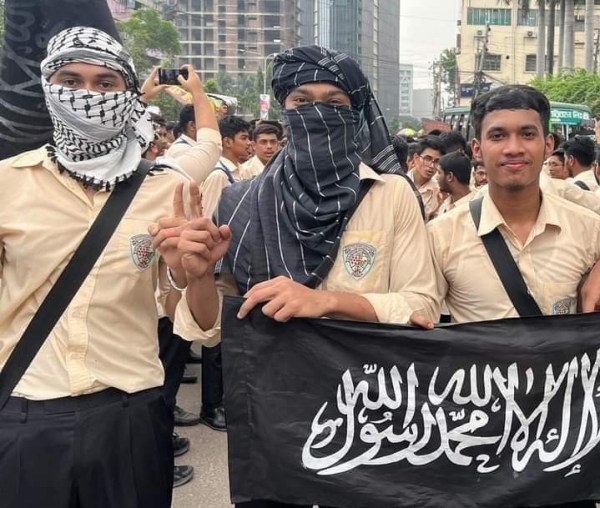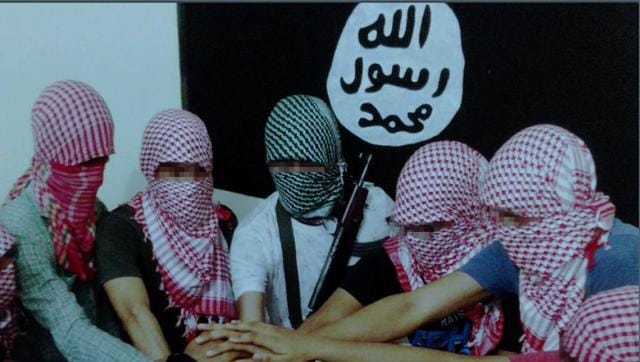The strategies and focus of Al-Qaeda in the Indian Subcontinent (AQIS) and the Islamic State of Iraq and Syria (ISIS) in Bangladesh reflect their broader organizational goals, operational approaches, and ideological underpinnings, tailored to the local context.
While both groups aim to establish Islamic governance and wage jihad, their methods, priorities, and engagement with Bangladesh differ significantly. Their key similarities include not exposing their patronizers in Jamaat-e-Islami and foreign donor organizations, hiding affiliations during demonstrations or social media campaigns, claiming responsibilities after each operation, hatred against democracy and secularism, and strict rules for the women.

AQIS pursues a patient, locally rooted strategy to erode secular governance and expand its influence, while ISIS seeks immediate impact through dramatic violence to bolster its global image. AQIS’s deeper historical ties to South Asian militancy give it a more entrenched presence, whereas ISIS’s appeal lies in its ruthless dynamism and broader recruitment pool. Both exploit Bangladesh’s socio-political vulnerabilities, but their differing methods reflect their distinct visions of jihad.
Terrific operations of Islamic State (ISIS) in Bangladesh
Jamaat-backed AQIS jihadists out to eliminate Awami League, hit India
AQIS in Bangladesh:
Established in September 2014 by Al-Qaeda leader Ayman al-Zawahiri, AQIS seeks to unify and strengthen jihadist efforts across South Asia, including Bangladesh, India, Pakistan, and Myanmar, with its headquarters in Pakistan. Initially, the Bangladesh part was known as Ansarullah Bangla Team and later Ansar al-Islam.
In Bangladesh, AQIS focuses on exploiting local grievances, particularly perceived injustices against Muslims, to build a broader support base. It frames its mission within an Islamic eschatological narrative, such as Gazwatul Hind (the prophesied battle of India), which envisions a regional jihad to “liberate” Muslims from secular or “apostate” governments. AQIS aims to establish a Sharia-based Islamic state in Bangladesh as part of a larger subcontinental caliphate.
Alliance with Local Groups: AQIS aligns with established Bangladeshi militant outfits like Harkat-ul-Jihad al-Islami Bangladesh (HuJI-B), Jama’atul Mujahideen Bangladesh (JMB), Hizb ut-Tahrir, Arakan Rohingya Salvation Army (ARSA), Rohingya Solidarity Organization (RSO), Jama’atul Ansar Fil Hindal Sharqiya and Qawmi madrasa-linked radical groups, like Hefazat-e-Islam. These associated groups provide AQIS with training, logistics and foot soldiers.
Targeted Assassinations: AQIS has claimed responsibility for small-scale, targeted attacks, such as the killings of secular bloggers, writers, war crimes trial campaigners, and LGBT activists between 2013 and 2016, using rudimentary weapons like machetes. These attacks aimed to silence voices opposing their ideology and intimidate civil society. The Awami League government bowed to their demands by arresting some secularists and atheists as per the list provided by the AQIS sympathizers and revised textbooks.
Propaganda and Recruitment: AQIS employs Bengali-language propaganda, including videos and translated versions of Al-Qaeda’s Inspire magazine and speeches by local Islamic orators, to recruit locally. It emphasizes protecting Muslims from perceived oppression, appealing to religious sentiments rather than territorial control. After their last operation in 2016, AQIS said they’d focus on social media campaigns to drum up public support and became successful.
Long-Term Embedding: AQIS pursues a population-centric strategy, seeking to embed itself within local communities by addressing grievances (e.g., Rohingya persecution or Hindu-Muslim tensions) and avoiding overt confrontation with the state that might provoke a severe crackdown. In response, they were able to gain support from different Islamist groups, liberal Muslims, and rights activists.
Priorities in Bangladesh: AQIS prioritizes ideological influence and gradual expansion over immediate territorial gains. Its focus is on destabilizing Bangladesh’s secular government and fostering a jihadist movement that aligns with Al-Qaeda’s global vision, while maintaining ties with regional affiliates.

ISIS in Bangladesh:
ISIS views Bangladesh as a peripheral but strategic staging ground for its regional operations, particularly as part of its broader Wilayat Khorasan (South and Central Asia province) ambitions. Unlike AQIS, ISIS emphasizes establishing a tangible caliphate and uses Bangladesh to project its global brand of violent jihad. It seeks to inspire and direct attacks that garner international attention, portraying itself as a dynamic and uncompromising force compared to Al-Qaeda.
High-Profile Attacks: ISIS has claimed responsibility for more sophisticated and high-visibility attacks in Bangladesh, such as the July 2016 Holey Artisan Bakery attack in Dhaka, which killed 22 people, mostly foreigners, and the gun attack on the Sholakia Eid congregation. These operations aimed to demonstrate capability, attract recruits, and challenge the government’s authority. In response, the government retaliated with heavy force, raiding its training centers and shelter homes, and killing over 100 of its leaders and fighters.
Collaboration with Local Militants: ISIS partnered with groups like JMB, HuJI-B and Hizb ut-Tahrir. JMB’s shift in allegiance from Al-Qaeda to ISIS around 2014-2015 bolstered ISIS’s foothold in Bangladesh.
Recruitment from Diverse Backgrounds: Unlike AQIS’s focus on traditional militant networks, ISIS targets a broader demographic, including educated, urban youth from mainstream institutions, military officials and the Bangladeshi diaspora (e.g., in the UK). This reflects its global recruitment strategy and use of social media for radicalization.
Sectarian Violence: ISIS employs brutal tactics, such as beheadings and attacks on religious minorities (e.g., Shia, Hindus, Christians, Buddhists and Ahmadiyya), to sow sectarian discord and assert dominance, mirroring its approach in Iraq and Syria. They prioritized rapid, spectacular violence to establish its relevance and inspire lone-wolf attacks globally. It considered Bangladesh as a launchpad for regional influence rather than a primary territory for governance, focusing on disruption over sustained control.

Key Differences:
-AQIS aims for a regional caliphate encompassing the Indian subcontinent, with Bangladesh as one part of a larger puzzle.
-ISIS focuses on integrating Bangladesh into its global caliphate, using it as a symbolic and operational outpost rather than a regional endgame.
-AQIS prefers low-profile, incremental attacks (e.g., assassinations) to build grassroots support and avoid overwhelming state retaliation.
-ISIS opts for high-impact, media-amplified attacks to project power and attract international recruits.
-AQIS emphasizes alliances with local groups and a narrative of defending Muslims, seeking to integrate into Bangladeshi society over time.
-ISIS exploits local networks but prioritizes its global brand, often alienating potential supporters with its extreme tactics and lack of focus on local governance.
-AQIS aligns with Al-Qaeda’s “far enemy” strategy (targeting Western influence and its allies), adapted to regional anti-India and anti-secular rhetoric.
-ISIS adheres to a “near enemy” approach, attacking local “apostates” and minorities to purify the Islamic community, with less emphasis on Western targets in Bangladesh.


Leave a Reply
You must be logged in to post a comment.